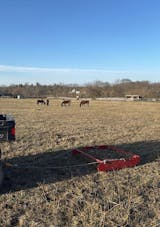
Horses have played an integral part in all aspects of human history, and they were exceptionally useful during both World Wars.
Continue reading to learn more about how horses were used in World War I and II.

Horses In World War I
It is currently estimated that somewhere between 6-8 million horses served in World War I, which spanned from July 1914 to November 1918.
Motorized vehicles were a relatively new invention and were gaining popularity, but they were still often prone to mechanical issues. In many cases, horses proved to be a reliable, cost-effective, and time-tested method of transport that was favored over the use of vehicles.
Below are some examples in which horses served the cause:

Supply Transport
While they were gaining popularity, motorized vehicles were yet not widely in use during World War I. Much of the on-ground transport of goods was dependent upon horses.
Supplies - such as food, water, medicine, and ammunition - for the war were shipped internationally. From the ports, trains would carry them to supply depots or regulating stations. Horses were then used to transport goods and supplies to the frontlines.
Horses were ideal for transporting goods to the front, as they were able to easily navigate much of the same terrain that soldiers navigated by foot.
Goods were typically packed into large wagons. In instances in which roads had been destroyed or the terrain was rough, supplies would be packed onto the horses’ backs instead. Horses can pull a significantly larger amount than they can have loaded upon their backs, but this was an excellent solution when wagons or vehicles could go no further.

Cavalry
The use of heavy artillery and trench warfare marked significant challenges for cavalry units, which were once an essential part of offensive warfare. While cavalry tactics once flourished and dominated in warfare, World War I proved to be a turning point.
While traditional offensive tactics such as mass cavalry charge were no longer effective and had to be revised, cavalry was still used for the following:
Reconnaissance
Defending the rear
Mobile firepower/infantry support
Prisoner escort
Ambulances
Horses were also used to pull ambulance wagons, which provided life-saving treatment and medicine for soldiers on the frontlines.
Ambulances were also used to quickly transport injured men to field hospitals. While the ride was often bumpy and uncomfortable due to road conditions.
Horse-drawn ambulances ensured that the men were able to make it to the hospital in time to receive the treatment they needed.
Lumber
Lumber was essential for the building of trenches and shelter on the front. Large horse-drawn carts and wagons were used to transport this vital supply where it was needed most.
Horses In World War II
World War II spanned between September 1939 and September 1945. Within these years, it is estimated that somewhere between 3-6 million horses were used for war efforts, though the exact number is not known.
While motorized vehicles were more developed and played a much larger role during World War II, horses were still very much relevant.
In fact, the greatest and most widescale use of horses for any wartime effort throughout history was by the Germans during World War II; it is recorded that nearly 80% of German efforts were horse-powered.
Below are some more examples in which horses served the cause during World War II:

Transportation
While motorized vehicles were the preferred method of travel, there were certain areas or regions that were far too remote or were far too rough. Horses were used as a crucial form of transportation in such regions.

Cavalry
Operating on knowledge acquired during World War I, cavalry forces navigated an increasingly motorized method of warfare.
Widespread use of tanks and machine guns made cavalry operations an extremely risky and dangerous affair. It was after just a few failed offensive cavalry missions that they became relatively obsolete, giving way to the use of tanks.
While cavalry forces were not nearly as prominent as they once were, cavalry horses assisted with:
Infantry support
Prisoner transport
Reconnaissance
Tank unit support
Security patrols

Supply Transport
Much like during the first World War, horses were used to transport essential goods to the frontlines, but typically only in areas in which roads had been destroyed, or the terrain was too rough even for the American Jeeps or trucks.
For the German forces, horse-drawn supply transport was absolutely crucial. Unlike their enemies, the Germans did not have easy access to fuel and could not keep up with vehicle production while simultaneously focusing on tank production.
Hence, most of the German supply transport (as well as the rest of their operations) was horse-drawn.

Ambulances
Motorized ambulances were in widespread use throughout World War II, but horse-drawn ambulances proved to be exceptionally useful in remote areas, regions with extremely uneven or rough terrain, or areas in which the roads had been destroyed.

Lasting Bonds
During both World Wars, the men on the frontlines formed strong bonds with the horses that they cared for and worked with.
By nature, horses are calm and gentle giants, eager to please. Equine casualties hit exceptionally hard for the men, and there are numerous written recollections of the lives and achievements of various different war horses.

Paddock Blade: Best Paddock Cleaning Tool
With the information you have learned here, you should have a solid understanding of just how important horses were during the course of both world wars.
As equestrians, we are incredibly thankful for the unforgettable and lasting impression horses continue to leave on our lives.
When it comes to maintaining and cleaning your paddocks and pastures, Paddock Blade has you covered.
Paddock Blade is proud to provide the best paddock cleaning tools on the market. We’re dedicated to helping hard-working equestrians simplify their everyday tasks so they can spend more time enjoying quality time with their horses.
To browse Paddock Blade’s inventory of industry-leading paddock cleaning tools, click here.
For more informative equestrian blogs, check out our blog page.





























